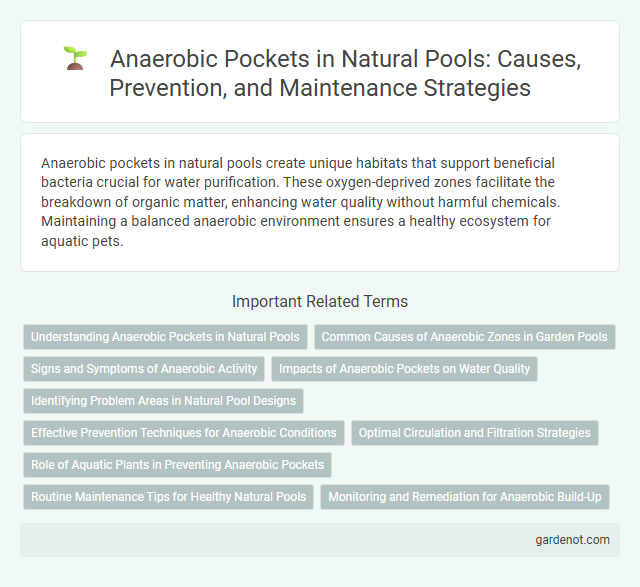Anaerobic pockets in natural pools create unique habitats that support beneficial bacteria crucial for water purification. These oxygen-deprived zones facilitate the breakdown of organic matter, enhancing water quality without harmful chemicals. Maintaining a balanced anaerobic environment ensures a healthy ecosystem for aquatic pets.
Understanding Anaerobic Pockets in Natural Pools
Anaerobic pockets in natural pools occur where oxygen levels are depleted, creating localized zones of low or no oxygen that influence water quality and ecosystem health. These pockets promote the growth of specific anaerobic bacteria responsible for nutrient cycling and organic matter decomposition, which can affect the pool's chemical balance. Understanding the dynamics of anaerobic pockets helps in maintaining natural pool filtration systems and preventing harmful buildup of gases like methane and hydrogen sulfide.
Common Causes of Anaerobic Zones in Garden Pools
Anaerobic pockets in natural garden pools often result from stagnant water areas where oxygen circulation is limited, promoting conditions for anaerobic bacteria to thrive. Common causes include overgrown vegetation blocking water flow, accumulated organic debris, and poor design features such as dead zones or insufficient water movement. These anaerobic zones can lead to unpleasant odors and harmful water quality, making regular maintenance and proper circulation essential.
Signs and Symptoms of Anaerobic Activity
Anaerobic pockets in natural pools often manifest through localized foul odors, murky water, and accumulation of sediments due to low oxygen levels inhibiting aerobic bacterial activity. Signs include discoloration of water and the presence of hydrogen sulfide gas, which produces a characteristic rotten egg smell. These symptoms indicate uneven oxygen distribution, promoting anaerobic bacteria growth that can impact water quality and aquatic life health.
Impacts of Anaerobic Pockets on Water Quality
Anaerobic pockets in natural pools create localized zones lacking oxygen, leading to the accumulation of harmful substances such as hydrogen sulfide and methane. These pockets disrupt the overall water quality by promoting the growth of anaerobic bacteria that degrade organic matter inefficiently, causing unpleasant odors and toxic conditions. The presence of anaerobic pockets negatively affects aquatic life by reducing oxygen availability and increasing nutrient imbalances, which can result in eutrophication and compromised ecosystem health.
Identifying Problem Areas in Natural Pool Designs
Anaerobic pockets in natural pool designs occur when water circulation is insufficient, leading to oxygen-deprived zones that promote harmful bacteria growth. Identifying these problem areas involves assessing stagnant water regions near bottom sediments or dense planting zones where organic matter accumulates. Effective design strategies prioritize continuous water movement to eliminate anaerobic pockets and maintain ecological balance.
Effective Prevention Techniques for Anaerobic Conditions
Effective prevention techniques for anaerobic conditions in natural pools include ensuring proper water circulation and oxygenation through strategic placement of aerators or pump systems. Introducing beneficial aerobic bacteria and maintaining a balanced aquatic plant ecosystem help consume excess nutrients that would otherwise contribute to anaerobic pockets. Regular monitoring of sediment accumulation and implementing controlled water flow prevent stagnant zones where oxygen depletion commonly occurs.
Optimal Circulation and Filtration Strategies
Optimal circulation and filtration strategies in natural pools prevent the formation of anaerobic pockets, which are low-oxygen zones that promote harmful bacterial growth. Ensuring strategic placement of pumps and biofilters promotes continuous water movement and oxygenation, effectively disrupting stagnant zones. Regular monitoring of flow patterns and adjusting return jets maintain balanced nutrient distribution, supporting a healthy aquatic ecosystem and clear water.
Role of Aquatic Plants in Preventing Anaerobic Pockets
Aquatic plants play a crucial role in preventing anaerobic pockets in natural pools by oxygenating the water through their root systems and leaves, which supports aerobic bacterial activity essential for breaking down organic matter. Their extensive root networks enhance water circulation and nutrient absorption, reducing stagnant zones where anaerobic conditions typically develop. By maintaining higher oxygen levels and promoting microbial balance, aquatic plants ensure a healthier, clearer natural pool ecosystem.
Routine Maintenance Tips for Healthy Natural Pools
Anaerobic pockets in natural pools can harbor harmful bacteria and degrade water quality if not properly managed. Regularly agitating sediment and ensuring adequate circulation prevents these pockets from forming, promoting a balanced ecosystem. Routine maintenance should include inspecting and cleaning biological filters to maintain oxygen levels and support beneficial microbial activity.
Monitoring and Remediation for Anaerobic Build-Up
Effective monitoring of anaerobic pockets in natural pools involves regular measurement of dissolved oxygen levels and redox potential to detect oxygen-depleted zones. Remediation techniques include increasing water circulation, introducing aeration systems, and adding oxygen-releasing compounds to restore aerobic conditions. Early detection and intervention prevent harmful buildup of anaerobic bacteria, ensuring healthy water quality and ecosystem balance.
Anaerobic pocket Infographic

 gardenot.com
gardenot.com